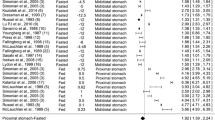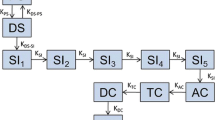Abstract
Purpose
Oral pH triggered drug delivery systems, for targeting to the lower gastrointestinal tract, show erratic behaviour in vivo. This study aimed to establish correlations between in situ gastrointestinal pH, transit time or feed status and the disintegration of pH-responsive dosage forms designed to dissolve above pH 7.
Methods
Tablets (radiolabelled with Technetium 99m) coated with Eudragit S were administered to eight healthy subjects in a three-way crossover study after an overnight fast. Food was administered either 30 min after (pre-feed) or 4 h after (fasted) tablet ingestion. Concurrently, a Bravo® pH monitoring capsule (radiolabelled with Indium 111) was administered in a “freefall manner”. In a third arm of the study tablets were given immediately after breakfast (fed). Transit was followed by gamma scintigraphy.
Results
Gastrointestinal pH showed variability between and within individuals but no differences were seen between pre-feed and fasted states. Three tablets failed to disintegrate in pre-feed and fed regimens and one in the fasted state; this has been tentatively linked to ileocaecal pH and ileoceacal junction residence time.
Conclusions
In vivo performance of “pH-responsive” dosage forms is complex and influenced by a multitude of factors other than just in situ pH.



Similar content being viewed by others
References
A. W. Basit. Advances in colonic drug delivery. Drugs. 65:1991–2007 (2005).
D. F. Evans, G. Pye, R. Bramley, A. G. Clark, T. J. Dyson, and J. D. Hardcastle. Measurement of gastrointestinal pH profiles in normal ambulant human subjects. Gut. 29:1035–1041 (1988).
H. M. Fadda, M. C. Hernández, D. N. Margetson, S. M. McAllister, A. W. Basit, S. Brocchini, and N. Suárez. The molecular interactions that influence the plasticizer dependent dissolution of acrylic polymer films. J. Pharm. Sci. in press (2008). DOI 10.1002/jps.21292.
M. J. Dew, P. J. Hughes, M. G. Lee, B. K. Evans, and J. Rhodes. An oral preparation to release drugs in the human colon. Br. J. Clin. Pharmacol. 14:405–408 (1982).
K. W. Schroeder, W. J. Tremaine, and D. M. Ilstrup. Coated oral 5-aminosalicylic acid therapy for mildly to moderately active ulcerative-colitis - a randomized study. N. Engl. J. Med. 317:1625–1629 (1987).
A. Sinha, D. Ball, A. L. Connor, J. Nightingale, and I. R. Wilding. Intestinal performance of two mesalamine formulations in patients with active ulcerative colitis as assessed by gamma scintigraphy. Pract. Gastroenterol. 27:56–69 (2003).
A. V. Safdi. Determination of 5-ASA in whole or partial mesalamine delayed-release tablets recovered from fecal samples of healthy volunteers. Am. J. Gastroenterol. 100:S159 (2005).
M. Ashford, J. T. Fell, D. Attwood, H. Sharma, and P. J. Woodhead. An in-vivo investigation into the suitability of pH dependent polymers for colonic targeting. Int. J. Pharm. 95:193–199 (1993).
V. C. Ibekwe, F. Liu, H. M. Fadda, M. K. Khela, D. F. Evans, G. E. Parsons, and A. W. Basit. An investigation into the in vivo performance variability of pH responsive polymers for ileo-colonic drug delivery using gamma scintigraphy in humans. J. Pharm. Sci. 95:2760–2766 (2006).
I. R. Wilding. A scintigraphic study to evaluate what happens to Pentasa and Asacol in the human gut. Pract. Gastroenterol. 23(11 Suppl):1–9 (1999).
J. Fallingborg, L. A. Christensen, M. Ingeman-Nielsen, B. A. Jacobsen, K. Abildgaard, and H. H. Rasmussen. pH-profile and regional transit times of the normal gut measured by a radiotelemetry device. Aliment. Pharmacol. Ther. 3:605–613 (1989).
A. H. Raimundo, D. F. Evans, J. Rogers, and D. B. Silk. Gastrointestinal pH profiles in ulcerative colitis. Gastroenterology 102: Abstract A681 (1992)
V. C. Ibekwe, H. M. Fadda, G. E. Parsons, and A. W. Basit. A comparative in vitro assessment of the drug release performance of pH-responsive polymers for ileo-colonic delivery. Int. J. Pharm. 308:52–60 (2006).
E. M. Ward, K. R. Devault, E. P. Bouras, M. E. Stark, H. C. Wolfsen, D. M. Davis, S. I. Nedrow, and S. R. Achem. Successful oesophageal pH monitoring with a catheter-free system. Aliment. Pharmacol. Ther. 19:449–454 (2004).
G. Scarpulla, S. Camilleri, P. Galante, M. Manganaro, and M. Fox. The impact of prolonged pH measurements on the diagnosis of gastroesophageal reflux disease: 4-day wireless pH studies. Am. J. Gastroenterol. 102:2642–2647 (2007).
L. Kalantzi, K. Goumas, V. Kalioras, B. Abrahamsson, J. B. Dressman, and C. Reppas. Characterization of the human upper gastrointestinal contents under conditions simulating bioavailability/bioequivalence studies. Pharm. Res. 23:165–176 (2006).
J. B. Dressman, R. R. Berardi, L. C. Dermentzoglou, T. L. Russell, S. P. Schmaltz, J. L. Barnett, and K. M. Jarvenpaa. Upper gastrointestinal (GI) pH in young, healthy-men and women. Pharm. Res. 7:756–761 (1990).
T. L. Russell, R. R. Berardi, J. L. Barnett, L. C. Dermentzoglou, K. M. Jarvenpaa, S. P. Schmaltz, and J. B. Dressman. Upper gastrointestinal Ph in 79 healthy, elderly, North-American men and women. Pharm. Res. 10:187–196 (1993).
C. T. Richardson, J. H. Walsh, M. I. Hicks, and J. S. Fordtran. Studies on mechanisms of food-stimulated gastric-acid secretion in normal human subjects. J. Clin. Invest. 58:623–631 (1976).
R. L. Bown, J. A. Gibson, G. E. Sladen, B. Hicks, and A. M. Dawson. Effects of lactulose and other laxatives on ileal and colonic Ph as measured by a radiotelemetry device. Gut. 15:999–1004 (1974).
K. Ewe, S. Schwartz, S. Petersen, and A. G. Press. Inflammation does not decrease intraluminal pH in chronic inflammatory bowel disease. Dig. Dis. Sci. 44:1434–1439 (1999).
S. J. Meldrum, H. C. Riddle, G. E. Sladen, B. W. Watson, and R. L. Bown. pH profile of gut as measured by radiotelemetry capsule. Br. Med. J. 2:104–106 (1972).
S. S. Davis, J. G. Hardy, and J. W. Fara. Transit of pharmaceutical dosage forms through the small intestine. Gut. 27:886–892 (1986).
C. Tuleu, A. W. Basit, W. A. Waddington, P. J. Ell, and J. M. Newton. Colonic delivery of 4-aminosalicylic acid using amylose-ethylcellulose-coated hydroxypropylmethylcellulose capsules. Aliment. Pharmacol. Ther. 16:1771–1779 (2002).
J. G. Hardy, D. F. Evans, I. Zaki, A. G. Clark, H. H. Tonnesen, and O. N. Gamst. Evaluation of an enteric coated naproxen tablet using gamma-scintigraphy and pH monitoring. Int. J. Pharm. 37:245–250 (1987).
K. P. Steed, G. Hooper, N. Monti, M. S. Benedetti, G. Fornasini, and I. R. Wilding. The use of pharmacoscintigraphy to focus the development strategy for a novel 5-ASA colon targeting system (“TIME CLOCK (R)” system). J. Control. Release. 49:115–122 (1997).
F. Gotch, J. Nadell, and I. S. Edelman. Gastrointestinal water and electrolytes. IV. The equilibration of deuterium oxide (D2O) in gastrointestinal contents and the proportion of total body water (T.B.W.) in the gastrointestinal tract. J. Clin. Invest. 36:289–296 (1957).
J. H. Cummings, J. G. Banwell, I. Segal, N. Coleman, H. N. Englyst, and G. T. Macfarlane. The amount and composition of large bowel contents in man. Gastroenterology 98:A408 (1990).
C. Schiller, C. P. Frohlich, T. Giessmann, W. Siegmund, H. Monnikes, N. Hosten, and W. Weitschies. Intestinal fluid volumes and transit of dosage forms as assessed by magnetic resonance imaging. Aliment. Pharmacol. Ther. 22:971–979 (2005).
T. T. Kararli, C. F. Kirchhoff, and J. E. Truelove. Ionic strength dependence of dissolution for Eudragit S-100 coated pellets. Pharm. Res. 12:1813–1816 (1995).
H. M. Fadda, and A. W. Basit. Dissolution of pH responsive formulations in media resembling intestinal fluids: bicarbonate versus phosphate buffers. J. Drug Del. Sci. Tech. 15:273–279 (2005).
E. M. Persson, A. S. Gustafsson, A. S. Carlsson, R. G. Nilsson, L. Knutson, P. Forsell, G. Hanisch, H. Lennernas, and B. Abrahamsson. The effects of food on the dissolution of poorly soluble drugs in human and in model small intestinal fluids. Pharm. Res. 22:2141–2151 (2005).
Author information
Authors and Affiliations
Corresponding author
Rights and permissions
About this article
Cite this article
Ibekwe, V.C., Fadda, H.M., McConnell, E.L. et al. Interplay Between Intestinal pH, Transit Time and Feed Status on the In Vivo Performance of pH Responsive Ileo-Colonic Release Systems. Pharm Res 25, 1828–1835 (2008). https://doi.org/10.1007/s11095-008-9580-9
Received:
Accepted:
Published:
Issue Date:
DOI: https://doi.org/10.1007/s11095-008-9580-9




